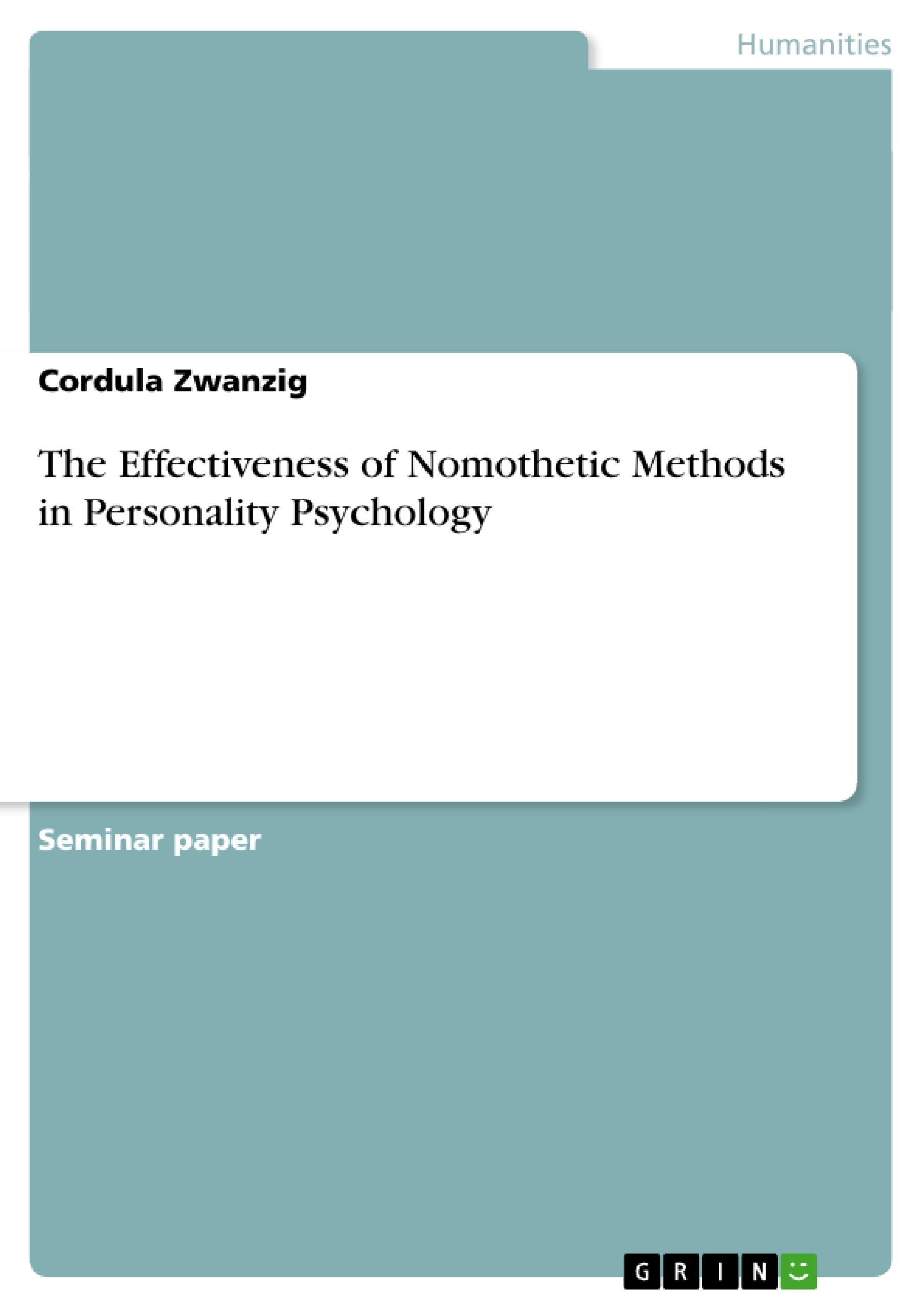This essay aims to prove the effectiveness of nomothetic approaches in personality research and general applicability. It will not ignore the advantages of idiographic methods but then emphasize the theoretical pre-eminence and empirical benefits of nomothetic ideas. Evaluation strategies based on L. A. Pervin and Maltby et al. shall answer the question why desired outcomes are being achieved more frequently by the nomothetic paradigm. Finally, this paper should demonstrate that in dealing with the complexity of human personalities, profound investigations might sometimes be more interesting but almost never more effective.
The Effectiveness of Nomothetic Methods in Personality Psychology
Introduction
“To live is the rarest thing in the world. Most people exist, that is all.” According to Oscar Wilde’s statement, thus, there are only two types of people on this earth: the ones, who actively enjoy, suffer from, and change their lives by taking it in their own hands and, on the other hand, the ones who passively sit and wait for what the world might put into their lap. In terms of personality psychology, this would mean that the writer follows a nomothetic concept assuming to find a finite number of character traits in his fellow men. A habit of dandies, however, it is, too, to nonchalantly explain away complex issues of society in a few words.
This essay therefore aims to scientifically prove the effectiveness of nomothetic approaches in personality research and general applicability. It will not ignore the advantages of idiographic methods but then emphasize the theoretical pre-eminence and empirical benefits of nomothetic ideas. Evaluation strategies based on L. A. Pervin and Maltby et al. shall answer the question why desired outcomes are being achieved more frequently by the nomothetic paradigm (Pervin, 2003, 423ff; Maltby et al., 2010, 15). Finally, this paper should demonstrate that in dealing with the complexity of human personalities, profound investigations might sometimes be more interesting but almost never more effective.
Comparison with Idiographic Approaches
The main aim of personality psychology is to integrate various detected individual differences into one theoretical construct in order to develop strategies for psychological diagnosis. In Ancient Greece, people were figuratively coined, they had a χαρακτήρας. This alludes to the presumption of certain given and stable vόμouς among human personalities. On the contrary, idiographic researchers assume an infinite number of character traits within each individual or, at least, an infinite number of combinations of traits (Maltby et al., 2010, 8; Pervin, 2003, 66; Chammorro-Premuzic, 2011, 27).
Logically, the latter can be the only acceptable method when a profound understanding of a single person’s psyche is aimed for because it would not spare any particularities for the sake of group average statistics. Since nomothetic approaches use quantitative methods, for instance, “(…) the correlation between resources and [subjective well-being] across people may be modest when analysed in a nomothetic way because of the fact that people's goals differ so much”, even though individuals might display extremer goals (Diener & Fujita, 1995, 927).
On the basis of evaluation criteria as presented in Maltby et al. (Maltby et al., 2010, 15), given explanations for various observable behavior are formulated in more detail than nomothetic theories would ever intend to. The main if not the most revolutionary contributor to clinical, also known as idiographic methods in the nineteenth century was Sigmund Freud. Freud was convinced fixation and medicamentous treatment would not lead to the recuperation of his patients. Instead the in-depth studies of his long-term hysterical patients, the psychoanalysis, consisted of extensive interviews, dream analysis, sentence completion and free association tasks (Freud, 1953, 250ff; Maltby et al., 2010, 35f). Giving detailed descriptions of facial expressions and features and often also directly quoting one of his first patients,Frau Emmy von N., Freud tried to reach the core of her private persona (Freud, 1955, 48ff; Mayer, 2007, 50f). Mainly through attentive listening, he connected childhood experiences with present behavior and thus retrieved what might have travelled from a conscious memory to the unconscious.
Freud would read seemingly incoherent desires and anxieties out of these talks and eventually construct his theory of personality (Pervin, 2003, 5/ 10). In a bottom-up procedure, he compiled a variety of phenomena and qualitative rich data he had collected over the years and generalized his findings (Maltby et al., 2010, 8). For example, several coping strategies detected in his case studies and herefrom extracted parallels proved his systematization of defense mechanisms (Maltby et al., 2010, 29ff/ 63ff/ 247). His complex therapeutic analyses led him to conclude everybody had their unique personality due to different combinations of character traits and reactions in different situations but that there also exist parallels between personalities (Maltby et al., 2010, 9f).
Obviously, his idiographic concept achieves a much deeper insight into the psyche of a person which is why some researchers have denied the existence of any generalized personality types entirely (Maltby et al., 2010, 8). When, however, the effectiveness of these two paradigms is to be assessed, the focus lies less on the understanding of the reasons and more on the results and the promptness with which they can be measured.
[...]
- Quote paper
- Cordula Zwanzig (Author), 2013, The Effectiveness of Nomothetic Methods in Personality Psychology, Munich, GRIN Verlag, https://www.grin.com/document/268135
-

-

-

-
Upload your own papers! Earn money and win an iPhone X. -

-
Upload your own papers! Earn money and win an iPhone X. -

-
Upload your own papers! Earn money and win an iPhone X. -

-
Upload your own papers! Earn money and win an iPhone X. -

-
Upload your own papers! Earn money and win an iPhone X.

